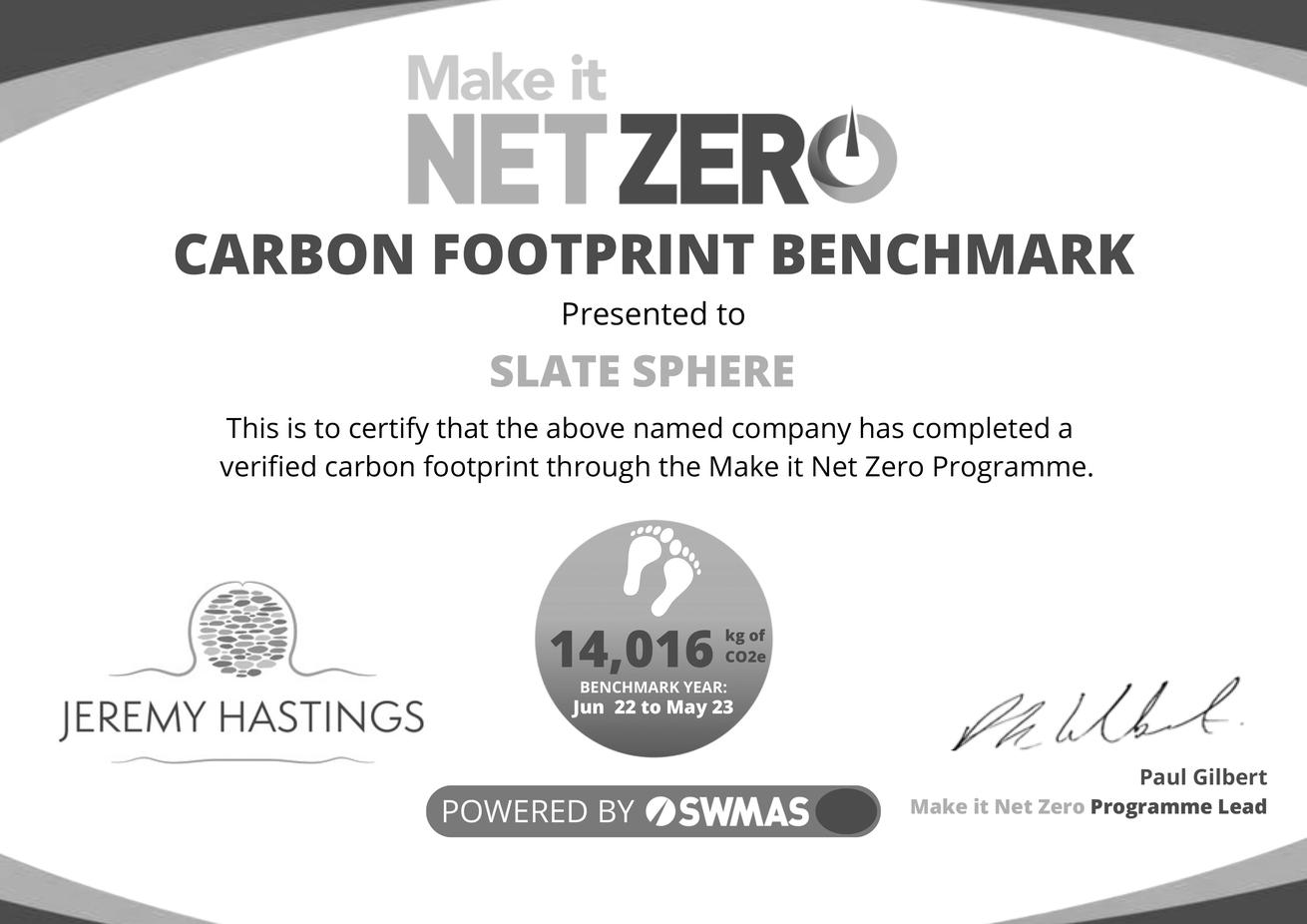Our Net Zero Journey
Here, at Jeremy Hastings, one of our core values is taking pride in our work. We are proud of the product we make by hand and love seeing our water spheres as a finished product in customers gardens. We are proud to be making a product that is UK made. We source our own slate from the quarry, and follow its journey through production into a beautiful feature at the end. We use the slate from the quarry that is otherwise disregarded as a waste product from companies needing much larger pieces of slate. By not creating any additional Carbon Footprint in the quarry itself, other than our short journey in picking the slate up, this began our thinking and beginnings of our journey into analysing what our actual carbon footprint for the company is and how we can set the wheels in motion to begin our Net Zero Journey.
The process with SWMAS’s Net Zero Programme has been very straight forward. We simply began a consultation process about our business and what it entails and provided figures around energy bills and fuel consumption for SWMAS to produce our bench mark report. The results for our last financial year are as follows:
Carbon Baseline: June 2022 – May 2023 Total Footprint =14,016 kg C02e 73.77 kg per £1000 turnover 2336 kg per employee
Putting 14,016kg into context – the average UK resident has a footprint of around 10,000 Kg. This is also the equivalent of driving 56,000 Km. When we tried to equate this figure for something personal to us, we thought back to when we (Jeremy and Victoria) in the earlier days of dating, drove around Australia in a Toyota Hiace in 2006. This was about 26,000 Kilometres and took about 6 months. So, for us, our business carbon footprint is just over double this! We would have loved to explore another 26,000 Km!

What does this mean for us now?
The advice first is to always AVOID unnecessary emissions.
Van Emissions: The Van vehicle mileage 13,022 kgCo2e. 92.9% Mileage data supplied for the company van showed it covers an average 3,300 miles a month, totalling 39,600 for the benchmark year. The Van is used for material collection from the quarry and to deliver the finished product to the customer. The van emissions contribute over 90% of the total footprint for the business.
Due to the long delivery distances and payload weight of the spheres a switch to electric is not viable and also the cost of such a vehicle would be prohibitive for our small business.
| Subject to the suitability of the van engine it could consider alternative fuels such as HVO (HVO Fuel - Definition, Benefits, & Importance | HVO Fuel UK) which would see the emissions drop by 98%. In addition since HVO is not available at the forecourt the business would need secure storage at its manufacturing unit, this is currently not a viable option right now either. |
What we already do however and will continue to do is try to group our installations around the country together. It might mean an overnight stay somewhere between installations but it does mean a lot less time on the road. We will continue to monitor the production and progress of electric vans and hopefully this is something we can consider in the future.
Electricity
Electricity measures 958 kgCo2e, just 6.83% of our total emission. The business has a modest electricity consumption for the process machinery using just 4,144KwH of electricity across the baseline year. Most of our product is made by hand and traditional methods of splitting slate. From the supplier (EDF Energy) fuel mix disclosure specified the electricity was supplied on a standard/mixed generation with a substantial impact to Scope 2 emissions.
A simple quick solution will be to switch to a 100% Renewable or Zero Carbon Tarriff at the next contract renewal as this would save over 90% of the emissions from our energy usage.
Water
Water supply and treatment is 3kg Co2e 2.26% The business uses water during its production process and therefore this was included in the data collection. Across the benchmark year the business used 103 cubic meters of water. Using the published conversion figures from GHG/DENZ this accounted only a minor level of emissions. However, reducing water consumption is another drive for our business in terms of our wider sustainability ethos.
We will minimise water use where possible and install water butts for use of watering our show stand plants.
In summary the emissions from the van is our biggest challenge for the company. Due to our usage profile and current EV technology a switch to electric is not viable, however subject to vehicle suitability a switch to HVO fuel would see a significant reduction in emissions. A switch to 100% green electricity would achieve another significant reduction in carbon and linked to installation of PV would lower emissions even further if commercially feasible The business has a modest impact in its operations comparable to that of 1.5 typical UK residents.
Our products are built to last a lifetime and do re purpose waste materials. We could now explore wider Scope 3 impacts like staff commuting to build a bigger picture of our impact. Although, our staff live within 10 miles of the workshop (including ourselves) and they already share lifts when possible. Well done staff 😊
In Short, we will:
- Continue to group installations around the country together where possible
- Switch Energy tariffs to green electricity tariff when our contract renews in 2025
- Purchase water butts
- Off-set our current carbon emissions through planting more trees
- Look into local schemes about giving back to our environment.
- Encourage our customers to buy a product in the UK to help reduce carbon emissions 😊
